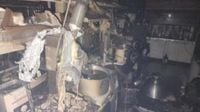On the evening of June 4, 2025, a sudden explosion followed by a fire rocked the fifth floor laboratory of the Life Sciences Engineering Department at the Korea Advanced Institute of Science and Technology (KAIST) in Yuseong-gu, Daejeon. The incident, which occurred at 9:52 PM, prompted a swift emergency response and left one young woman seriously injured.
The fire department dispatched 25 fire trucks and 60 personnel to the scene, who worked diligently to extinguish the blaze. After approximately 33 minutes, the fire was brought under control by 10:25 PM, preventing what could have been a far more devastating disaster in one of South Korea's leading research institutions.
The explosion reportedly took place during an experiment involving acetone, a volatile and highly flammable chemical commonly used in laboratories. According to witness accounts collected by police and fire authorities, the blast happened suddenly, catching those present off guard.
Among the individuals affected, a woman in her twenties, identified as Ms. A, sustained significant injuries. She suffered lacerations and second-degree burns on her face, back, and left hand. Emergency medical teams transported her to a hospital for urgent treatment. In addition to Ms. A, four other people who were in the laboratory at the time inhaled smoke but did not require hospital admission.
More than 30 people were evacuated from the building as a precautionary measure during the incident, underscoring the seriousness with which the emergency was handled. The rapid response by the Daejeon Yuseong Fire Department was crucial in containing the fire and ensuring the safety of everyone involved.
Authorities are currently conducting a thorough investigation into the precise cause of the explosion. While acetone use during the experiment is suspected as the trigger, officials are examining all factors to determine how the accident occurred and to prevent similar incidents in the future.
KAIST, renowned for its cutting-edge scientific research and innovation, has not previously experienced such a severe laboratory accident. This event has raised concerns about laboratory safety protocols and the handling of hazardous materials in research environments.
Experts emphasize that acetone, while commonly used in chemical laboratories, must be handled with extreme caution due to its flammability and potential to cause explosive reactions under certain conditions. The incident serves as a stark reminder of the risks inherent in scientific experimentation and the vital importance of stringent safety measures.
Local authorities and KAIST officials have pledged full cooperation with investigators and have expressed their commitment to reviewing safety procedures. They aim to ensure that all laboratory activities adhere to the highest standards to protect researchers and staff.
The incident also drew attention to emergency preparedness within academic institutions. The coordinated effort between KAIST personnel and emergency responders was credited with minimizing harm and facilitating a swift resolution to the crisis.
As the investigation continues, the scientific community and the public await detailed findings that will shed light on the causes and consequences of this alarming event. Meanwhile, Ms. A remains under medical care, and her condition is being closely monitored.
This unfortunate accident at one of South Korea's premier science and technology centers underscores the delicate balance between pioneering research and safety. It serves as a call to action for institutions worldwide to rigorously evaluate and enhance their safety protocols to prevent future tragedies.





